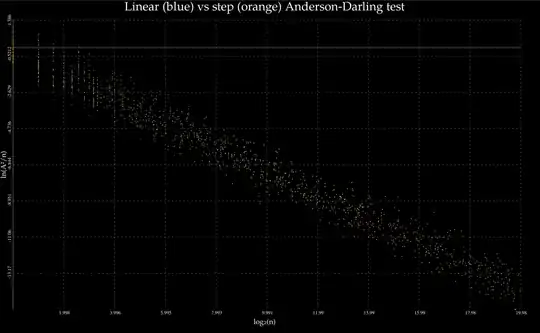I can't answer this question in full generality, but I think I can state one circumstance where it certainly is not useful: The Anderson-Darling test:
\begin{align*}
A^2/n &:= \int_{-\infty}^{\infty} \frac{(F_{n}(x) -F(x))^2}{F(x)(1-F(x))} \, \mathrm{d}F(x) \\
&= \int_{-\infty}^{x_0} \frac{F(x)}{1-F(x)} \, \mathrm{d}F(x) + \int_{x_{n-1}}^{\infty} \frac{1-F(x)}{F(x)} \, \mathrm{d}F(x) + \sum_{i=0}^{n-2} \int_{x_i}^{x_{i+1}} \frac{(F_n(x) - F(x))^2}{F(x)(1-F(x))} \mathrm{d}F(x)
\end{align*}
Here, $F$ is the cumulative distribution function of the normal distribution, namely,
$$
F(x) := \frac{1}{2}\left[1 + \mathrm{erf}\left(\frac{x}{\sqrt{2}}\right) \right]
$$
and $F_n$ is the empirical cumulative distribution function
$$
F_n(x) := \frac{1}{n} \sum_{i=0}^{n-1} \mathbb{1}_{x_i \le x}
$$
(We will abuse notation a bit and let $F_{n}$ denote the linearly interpolated version of $F_n$ as well.)
I repeatedly generated $n$ $~N(0,1)$ random numbers, sorted them, and then considered $F_n$ first as a step function, and then as a sequence of linear interpolants. Each interior integral was computed via Gaussian quadrature of ridiculously high degree, and the tails via exp-sinh.
Did the empirical distribution fit the cumulative distribution better with linear interpolation than step interpolation? No, in fact they are indistinguishable as $n\to \infty$ and one is not uniformly better than the other for small $n$:

Code to reproduce:
#include <iostream>
#include <random>
#include <utility>
#include <boost/math/distributions/anderson_darling.hpp>
#include <quicksvg/scatter_plot.hpp>
template<class Real>
std::pair<Real, Real> step_vs_linear(size_t n)
{
std::random_device rd;
Real mu = 0;
Real sd = 1;
std::normal_distribution<Real> dis(mu, sd);
std::vector<Real> v(n);
for (size_t i = 0; i < n; ++i) {
v[i] = dis(rd);
}
std::sort(v.begin(), v.end());
Real Asq = boost::math::anderson_darling_normality_step(v, mu, sd);
Real step = Asq;
//std::cout << "n = " << n << "\n";
//std::cout << "Step: A^2 = " << Asq << ", Asq/n = " << Asq/n << "\n";
Asq = boost::math::anderson_darling_normality_linear(v, mu, sd);
Real line = Asq;
//std::cout << "Line: A^2 = " << Asq << ", Asq/n = " << Asq/n << "\n";
return std::pair<Real, Real>(step, line);
}
int main(int argc, char** argv)
{
using std::log;
using std::pow;
using std::floor;
size_t samples = 10000;
std::vector<std::pair<double, double>> linear_Asq(samples);
std::vector<std::pair<double, double>> step_Asq(samples);
std::default_random_engine generator;
std::uniform_real_distribution<double> distribution(3, 18);
#pragma omp parallel for
for(size_t sample = 0; sample < samples; ++sample) {
size_t n = floor(pow(2, distribution(generator)));
auto [step , line] = step_vs_linear<double>(n);
step_Asq[sample] = std::make_pair<double, double>(std::log2(double(n)), std::log(step/n));
linear_Asq[sample] = std::make_pair<double, double>(std::log2(double(n)), std::log(line/n));
if (sample % 10 == 0) {
std::cout << "Sample " << sample << "/" << samples << "\n";
}
}
std::string title = "Linear (blue) vs step (orange) Anderson-Darling test";
std::string filename = "ad.svg";
std::string x_label = "log2(n)";
std::string y_label = "ln(A^2/n)";
auto scat = quicksvg::scatter_plot<double>(title, filename, x_label, y_label);
scat.add_dataset(linear_Asq, false, "steelblue");
scat.add_dataset(step_Asq, false, "orange");
scat.write_all();
}
Anderson-Darling tests:
#ifndef BOOST_MATH_DISTRIBUTIONS_ANDERSON_DARLING_HPP
#define BOOST_MATH_DISTRIBUTIONS_ANDERSON_DARLING_HPP
#include <cmath>
#include <algorithm>
#include <boost/math/distributions/normal.hpp>
#include <boost/math/quadrature/exp_sinh.hpp>
#include <boost/math/quadrature/gauss_kronrod.hpp>
namespace boost { namespace math {
template<class RandomAccessContainer>
auto anderson_darling_normality_step(RandomAccessContainer const & v, typename RandomAccessContainer::value_type mu = 0, typename RandomAccessContainer::value_type sd = 1)
{
using Real = typename RandomAccessContainer::value_type;
using std::log;
using std::pow;
if (!std::is_sorted(v.begin(), v.end())) {
throw std::domain_error("The input vector must be sorted in non-decreasing order v[0] <= v[1] <= ... <= v[n-1].");
}
auto normal = boost::math::normal_distribution(mu, sd);
auto left_integrand = [&normal](Real x)->Real {
Real Fx = boost::math::cdf(normal, x);
Real dmu = boost::math::pdf(normal, x);
return Fx*dmu/(1-Fx);
};
auto es = boost::math::quadrature::exp_sinh<Real>();
Real left_tail = es.integrate(left_integrand, -std::numeric_limits<Real>::infinity(), v[0]);
auto right_integrand = [&normal](Real x)->Real {
Real Fx = boost::math::cdf(normal, x);
Real dmu = boost::math::pdf(normal, x);
return (1-Fx)*dmu/Fx;
};
Real right_tail = es.integrate(right_integrand, v[v.size()-1], std::numeric_limits<Real>::infinity());
auto integrator = boost::math::quadrature::gauss<Real, 30>();
Real integrals = 0;
int64_t N = v.size();
for (int64_t i = 0; i < N - 1; ++i) {
auto integrand = [&normal, &i, &N](Real x)->Real {
Real Fx = boost::math::cdf(normal, x);
Real Fn = (i+1)/Real(N);
Real dmu = boost::math::pdf(normal, x);
return (Fn - Fx)*(Fn-Fx)*dmu/(Fx*(1-Fx));
};
auto term = integrator.integrate(integrand, v[i], v[i+1]);
integrals += term;
}
return v.size()*(left_tail + right_tail + integrals);
}
template<class RandomAccessContainer>
auto anderson_darling_normality_linear(RandomAccessContainer const & v, typename RandomAccessContainer::value_type mu = 0, typename RandomAccessContainer::value_type sd = 1)
{
using Real = typename RandomAccessContainer::value_type;
using std::log;
using std::pow;
if (!std::is_sorted(v.begin(), v.end())) {
throw std::domain_error("The input vector must be sorted in non-decreasing order v[0] <= v[1] <= ... <= v[n-1].");
}
auto normal = boost::math::normal_distribution(mu, sd);
auto left_integrand = [&normal](Real x)->Real {
Real Fx = boost::math::cdf(normal, x);
Real dmu = boost::math::pdf(normal, x);
return Fx*dmu/(1-Fx);
};
auto es = boost::math::quadrature::exp_sinh<Real>();
Real left_tail = es.integrate(left_integrand, -std::numeric_limits<Real>::infinity(), v[0]);
auto right_integrand = [&normal](Real x)->Real {
Real Fx = boost::math::cdf(normal, x);
Real dmu = boost::math::pdf(normal, x);
return (1-Fx)*dmu/Fx;
};
Real right_tail = es.integrate(right_integrand, v[v.size()-1], std::numeric_limits<Real>::infinity());
auto integrator = boost::math::quadrature::gauss<Real, 30>();
Real integrals = 0;
int64_t N = v.size();
for (int64_t i = 0; i < N - 1; ++i) {
auto integrand = [&](Real x)->Real {
Real Fx = boost::math::cdf(normal, x);
Real dmu = boost::math::pdf(normal, x);
Real y0 = (i+1)/Real(N);
Real y1 = (i+2)/Real(N);
Real Fn = y0 + (y1-y0)*(x-v[i])/(v[i+1]-v[i]);
return (Fn - Fx)*(Fn-Fx)*dmu/(Fx*(1-Fx));
};
auto term = integrator.integrate(integrand, v[i], v[i+1]);
integrals += term;
}
return v.size()*(left_tail + right_tail + integrals);
}
}}
#endif
